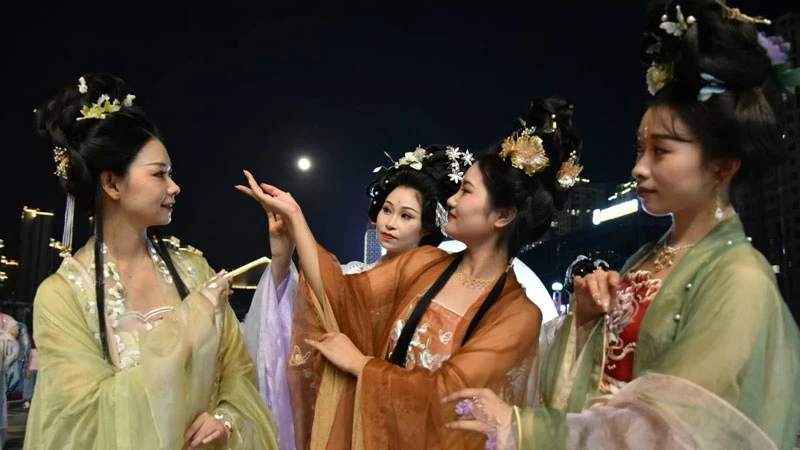From Classrooms to Weddings: Hanfu's Growing Presence in Everyday Life
As the Mid-Autumn Festival approaches, a fascinating trend is sweeping across China - the rising popularity of hanfu, traditional Chinese clothing. This resurgence is more than just a fashion statement; it's a cultural phenomenon that's reshaping how modern Chinese, especially the younger generation, connect with their heritage.
In recent years, hanfu has transcended its historical confines to become a vibrant part of contemporary Chinese life. From school performances and holiday photo-ops to Chinese-style weddings, the elegant silhouettes of hanfu are increasingly visible in everyday scenarios. This trend reflects a deeper shift in Chinese society - a growing appreciation for traditional culture and a burgeoning sense of cultural confidence among the youth.
The numbers tell a compelling story. Some hanfu stores report a four to five-fold increase in customers, with students making up the majority of this surge. This isn't just a local phenomenon; the popularity of hanfu, particularly styles like the horse-face skirt, has even caught international attention.

Li Fangguo (李方国), owner of a hanfu experience store, offers insight into this trend. His shop boasts over 500 sets of hanfu, ranging from styles of the Wei-Jin period to the Qing dynasty. "The hanfu we see today isn't just traditional Han Chinese clothing in the narrow sense," Li explains. "It's clothing that incorporates hanfu elements, even serving as a comprehensive cultural symbol embodying the essence of excellent Chinese traditional culture."
The appeal of hanfu extends beyond aesthetics. For many young people, wearing hanfu is a way to express their individuality while simultaneously connecting with their cultural roots. It's a tangible manifestation of China's growing cultural confidence, a bridge between its rich past and dynamic present.
The Economic and Cultural Impact of the Hanfu Revival
This cultural revival is having significant economic impacts. The Chinese hanfu market is projected to reach 24.18 billion yuan by 2027, up from 14.47 billion yuan in 2023. The trend is also boosting related industries such as cultural tourism, catering, and film and television production.
However, the hanfu revival isn't without its challenges. Industry insiders point out issues such as immature industry standards, arbitrary style changes, and over-catering to market demands. These are hurdles the industry will need to address as it continues to grow.
The popularity of hanfu also reflects broader societal changes in China. As living standards improve, people are increasingly focusing on spiritual and cultural pursuits. Young people, in particular, are seeking ways to express their individuality while also embracing their cultural heritage.
Li Fangguo sees his role as more than just a business owner. "I'm not just doing this to make money," he says. "Promotion is also very important. Hanfu embodies thousands of years of our ancestors' aesthetic pinnacle. Through our efforts, we hope everyone will come to love hanfu and our traditional culture."
This sentiment echoes across China as more people discover the beauty and significance of hanfu. Schools are incorporating hanfu into cultural education programs, tourists are packing hanfu for their travels, and themed events centered around traditional clothing are becoming increasingly popular.
The hanfu revival is more than just a fashion trend; it's a cultural movement that speaks to China's journey of self-discovery in the 21st century. As the nation continues to modernize at a breakneck pace, many Chinese are finding in hanfu a way to stay connected to their roots.
This blend of tradition and modernity is creating new opportunities and challenges. On one hand, it's fostering a deeper appreciation for Chinese history and craftsmanship. On the other, it's raising questions about authenticity and the commercialization of culture.
As the Mid-Autumn Festival approaches and more Chinese don hanfu to celebrate, it's clear that this trend is more than a passing fad. It represents a reimagining of Chinese identity in the modern world - one that honors the past while embracing the future.
The resurgence of hanfu is a testament to the enduring power of cultural heritage in shaping national identity. As China continues to navigate its place on the global stage, the flowing sleeves and intricate embroidery of hanfu serve as a reminder of the rich cultural tapestry that underlies its modern achievements.
The hanfu revival is about more than just clothing. It's about rediscovering a sense of cultural pride, fostering creativity, and building bridges between generations. As more Chinese youth embrace this traditional attire, they're not just wearing a piece of history - they're weaving themselves into the ongoing story of Chinese civilization.


